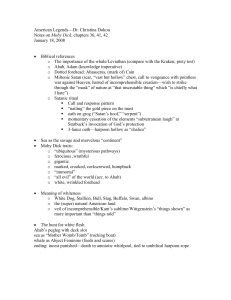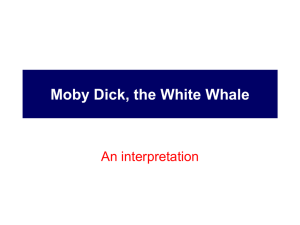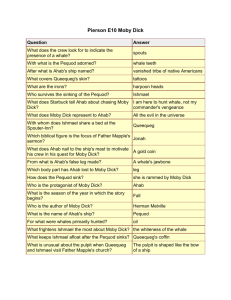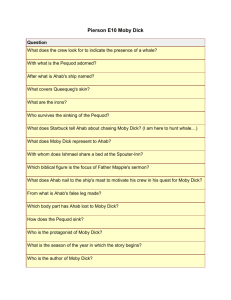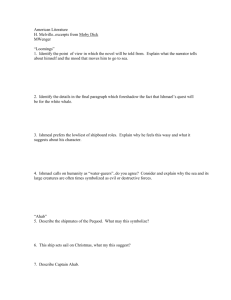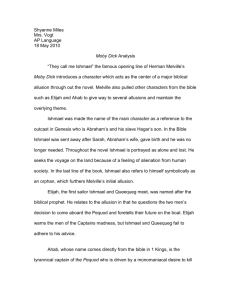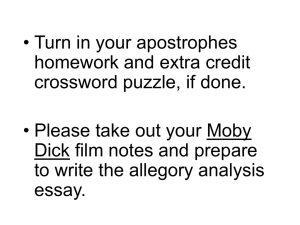Moby Dick Moby Dick Published in 1851 by Herman Melville Name
advertisement
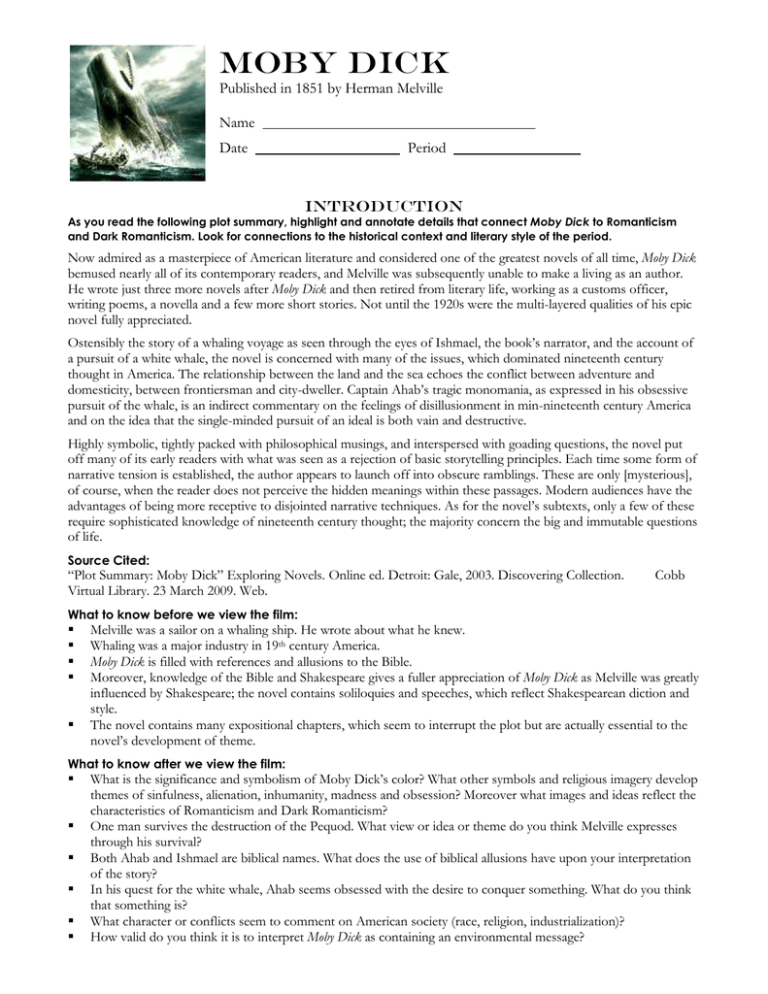
Moby Dick Published in 1851 by Herman Melville Name Date Period Introduction As you read the following plot summary, highlight and annotate details that connect Moby Dick to Romanticism and Dark Romanticism. Look for connections to the historical context and literary style of the period. Now admired as a masterpiece of American literature and considered one of the greatest novels of all time, Moby Dick bemused nearly all of its contemporary readers, and Melville was subsequently unable to make a living as an author. He wrote just three more novels after Moby Dick and then retired from literary life, working as a customs officer, writing poems, a novella and a few more short stories. Not until the 1920s were the multi-layered qualities of his epic novel fully appreciated. Ostensibly the story of a whaling voyage as seen through the eyes of Ishmael, the book’s narrator, and the account of a pursuit of a white whale, the novel is concerned with many of the issues, which dominated nineteenth century thought in America. The relationship between the land and the sea echoes the conflict between adventure and domesticity, between frontiersman and city-dweller. Captain Ahab’s tragic monomania, as expressed in his obsessive pursuit of the whale, is an indirect commentary on the feelings of disillusionment in min-nineteenth century America and on the idea that the single-minded pursuit of an ideal is both vain and destructive. Highly symbolic, tightly packed with philosophical musings, and interspersed with goading questions, the novel put off many of its early readers with what was seen as a rejection of basic storytelling principles. Each time some form of narrative tension is established, the author appears to launch off into obscure ramblings. These are only [mysterious], of course, when the reader does not perceive the hidden meanings within these passages. Modern audiences have the advantages of being more receptive to disjointed narrative techniques. As for the novel’s subtexts, only a few of these require sophisticated knowledge of nineteenth century thought; the majority concern the big and immutable questions of life. Source Cited: “Plot Summary: Moby Dick” Exploring Novels. Online ed. Detroit: Gale, 2003. Discovering Collection. Virtual Library. 23 March 2009. Web. Cobb What to know before we view the film: Melville was a sailor on a whaling ship. He wrote about what he knew. Whaling was a major industry in 19th century America. Moby Dick is filled with references and allusions to the Bible. Moreover, knowledge of the Bible and Shakespeare gives a fuller appreciation of Moby Dick as Melville was greatly influenced by Shakespeare; the novel contains soliloquies and speeches, which reflect Shakespearean diction and style. The novel contains many expositional chapters, which seem to interrupt the plot but are actually essential to the novel’s development of theme. What to know after we view the film: What is the significance and symbolism of Moby Dick’s color? What other symbols and religious imagery develop themes of sinfulness, alienation, inhumanity, madness and obsession? Moreover what images and ideas reflect the characteristics of Romanticism and Dark Romanticism? One man survives the destruction of the Pequod. What view or idea or theme do you think Melville expresses through his survival? Both Ahab and Ishmael are biblical names. What does the use of biblical allusions have upon your interpretation of the story? In his quest for the white whale, Ahab seems obsessed with the desire to conquer something. What do you think that something is? What character or conflicts seem to comment on American society (race, religion, industrialization)? How valid do you think it is to interpret Moby Dick as containing an environmental message? Moby Dick 2 Film notes and analysis 1. Famous opening line of the novel/film is “Call me Ishmael” 2. This shows that the novel is written in which point of view? 1st 3. Who narrates? Ishmael 4. Ishmael’s name is an allusion to what story? Ishmael is the illegitimate son of Abraham and Hagar in the Old Testamant. Abraham’s wife Sarah could not get pregnant and Abraham needed an heir, so he has Ishmael with Sarah’s servant Hagar. Later Sarah does get pregnant and gives birth to Isaac. These half brothers quarrel, and Ishmael leaves home putting a divide between two halves of the Jewish people. Many people and scholars look back to this family feud as one of the sources of division in the Middle East today. The allusion is important because Moby Dick’s Ishmael is a orphaned wanderer as well. Remember that Melville, as a Dark Romantic, features characters who are alienated or abandoned (in class I mentioned that Melville has “Daddy Issues” since he too was abandoned as a child. 5. Before Ishmael arrives in town, what characteristics of Romanticism are shown in the film’s imagery and in Ishmael’s desire to go to sea? Escapism: Ishmael leaves the problems of society, what he calls the “November of his soul,” to go to the sea; Importance of nature: the film shows nature at its most sublime or edenic. 6. When Ishmael arrives in New Bedford (name of town), he must obtain the permission from whom in order to go whaling? Why? The men of New Bedford must give outsiders permission to go whaling because they own the sea and all the whales in it. 7. Who do the men see walking alone? Ahab What is the mood and what does the mood seem to foreshadow about this man? The thump of his leg on the walkway, thunder and lightening as well as how the pub goes quiet as he passes makes the mood dark, dangerous, foreboding 8. What is symbolic about the church in New Bedford? The walls of the church are lined with markers for men who have died at sea. What does this seem to foreshadow? The danger, risk and destruction that can happen at sea The pulpit is in the form of the prow of a ship. The sermon is about Jonah and his disobedience. 9. When Ishmael first meets his roommate, he is distressed to learn Queequeg is a cannibal. Queequeg is from the islands to the south; he is the son of a king. How does he get on board his first ship? He stows away when the boat passes his island 10. How does Ishmael’s and Queequeg’s relationship change on Sunday? They become close friends, almost like brothers. Queequeg gives Ishmael half his money, and he gives Ishmael the power to decide the boat on which they will join. Moby Dick 3 11. Ishmael and Queequeg find a ship; Ishmael will earn 1/300th of the total earnings. 12. The men in charge first assert that Queequeg is not welcome because he is not a Christian; however they quickly change their minds when they see Queequeg do what? He throws the harpoon far and accurately. Queequeg will earn 1/33 of the total earnings. What other group of people do the men in charge reserve earnings for? Widows and orphans of men lost on previous voyages 13. Ishmael’s concerns about Captain Ahab come from what biblical allusion? Ahab is the wicked king of Sodom and Gomorrah (husband to Jezebel); Ishmael has also heard that Ahab’s mother found him wicked when he was born. 14. The ominous nature of this allusion is reinforced by the man named who Queequeg and Ishmael meet. Elijah (prophet who confronts Ahab in the Bible) warns the men (foreshadowing destruction): “You will smell land where there will be no land. Ahab will go to his grave and rise again and beckon. All but one will be lost. 15. How does Elijah’s name connect to the allusion to Ahab’s name? In other words, what was the relationship between Elijah and Ahab in the Bible? Elijah from the Old Testament is a prophet sent to warn Ahab to repent or God would destroy him. The biblical Ahab does not repent 16. Who do you think will survive? 17. On the Pequod, the crew come from “all the ends of the earth” 18. Pip, the cabin boy is from Alabama. 19. Throughout the film, look for differences between Starbuck, Stub, and Flask, the three mates who are in command of the ship under Captain Ahab. Look for their reactions to Ahab and the expedition: Starbuck, first mate, is a Quaker; he Stub, second mate, is known for Flask, third mate, is a is known for his courage which the what? His humor, good nature, and bully, who feels the whales have men should rely upon in times of his wisdom insulted him. need but not waste (honey metaphor). 20. Does the narrator use direct or indirect characterization to introduce the three mates? Direct 21. Critics credit Melville as one of the first authors to represent multicultural people; however, critics also criticize him because the three harpooners are second in social status to the mates and to Ahab. As you watch the film, consider whether you think his portrayal of Queequeg, Tashtego, and Daggoo (and Pip) is respectful and nuanced or whether it is stereotypical and tokenistic. Moby Dick 4 Queequeg is the first Tashtego is a Native American who Daggoo is from Africa, and he once harpooner who is from Polynesia. has come to hunt whale instead of killed a lion. buffalo For what purpose do you think Melville portrays the three harpooners as what he called “noble savages”? Multiple answers possible; Melville may be trying to emphasize primitive morality and skill in contrast to the hypocritical morality of civilized society. 22. Ahab, the captain of the ship, stays inside all day long. At night, however, the men hear him walking the deck. His artificial leg is made from the jawbone of a whale 23. Moby Dick is the name of a whale who is what color? white Why is it surprising that Moby Dick is white? What symbolic meaning does the color white suggest? White typically represents purity or innocence. 24. What reward will be given to the mastheader who spots Moby Dick? A gold coin 25. Moby Dick has harpoons sticking out of his body. What else is significant about how Ahab describes him? His fiery eyes, his crooked jaw, his broken tail all suggest the battles that Moby Dick has survived 26. Captain Ahab says the purpose of the voyage is to chase Moby Dick Mr. Starbuck asks Captain Ahab if Moby Dick took his leg Captain Ahab replies that Moby Dick took his soul from his body If you were on the Peaquod, what would you be thinking right now? 27. One of the sailors calls Moby Dick a great marble tombstone 28. When the sailors harpoon the whale, what mood does the music convey? Adventurous, jolly, exciting 29. Why does Ahab say they will go to the Pacific Ocean? Why is this unusual? To hunt Moby Dick; these are not the usual seas for hunting whales What does Starbuck question about this plan? That they are not fulfilling the purpose for coming to sea How does Ahab react? Angry that Starbuck questions his authority 30. Who says, “let Ahab beware Ahab”? What does he mean? Starbuck; he worries that Ahab’s vengeance will lead to his destruction 31. What does “thar she blows” mean? The mastheader has spotted a whale 32. The Peaquod meets up with the captain and crew of the Samuel Enderby. What do Ahab and the captain of the Enderby have in common? They each lost a limb to Moby Dick How do they differ (in attitude, manner, and beliefs)? The captain of the Enderby does not thirst for vengeance as Ahab does; in fact he is almost grateful to have lost his arm. He is happy and good-natured Moby Dick 5 33. What does Ahab learn about the white whale from the captain of the Enderby? That Moby Dick was spotted off the coast of Madagascar last month. Why will the captain of the Enderby not sail with Ahab? He does not want vengeance; he wants to stay in the whale-rich waters where they are 34. How do the mates react to Ahab’s decision to change course? They want to stay and finish the hunt (for profits and for blood-thirst) HINT: What are they doing when Ahab tells them to “cut loose”? bringing in a dead whale Answer later: What is ironic about this decision? They will cut loose the whales they have hunted and then they will find no other whales besides Moby Dick (once the wind and tide dies) 35. According to Starbuck, why does God bless their work, but he calls this voyage calls “evil” What is the difference? Starbuck sees a divine purpose in bringing light through whale oil to a thousand homes, but Ahab perverts this just purpose by hunting only his vengeance. 36. Ahab calls his hunt for Moby Dick his attempt to face what lurks “behind the pasteboard mask of society… the malignant thing behind the mask that man fears since life began” What is this thing that destroys men’s lives but does not kill them? Sin Look at the significance and meaning of the following phrases: o “lust for vengeance” o “champion of darkness” These phrases show the contrast between Starbuck’s goodness and the darkness of Ahab’s soul (pride/hubris, vengeance, wrath) 37. Who says, “There isn’t a man about who would rather be kicked by him than knighted by the Queen of England” What does he mean and why is this important? Return to this line later as well. Stubb means that men have pledged themselves to Ahab (mostly for the finanacial rewards – the gold coin) 38. At this point, a series of omens suggest a turn for the worse. What are they? The lookout falls from the masthead and the sea swallows him; he dies There is no wind so the ship will not move Ahab has spent seven days and seven nights on watch. Queequeg wants the carpenter to make a coffin for him. 39. All of these events foreshadow what? The destruction of the Peaquod and the death of the crew 40. Why is the narrator attacked and who saves him? Ishmael tries to stop the men from harming Queequeg, and they attack him. Queequeg wakes from his trance and saves Ishmael. 41. What is the effect of all the birds flying about the men? They are stunned to see birds in the middle of the ocean; the birds circle the men’s boats to eerie effect. They lose track of Moby Dick. 42. There is no wind, so how does Ahab move the boat? The men pull it by rowing in the smaller boats What will this do to the men? Tire them out (as well as giving blood to temper the new harpoons that the blacksmith is smelting) Moby Dick 6 43. What does Ahab promise to the men once Moby Dick is killed? His share of the Peaquod’s profits 44. The Rachel out of New Bedford tells Ahab that they have seen the white whale. But Captain Gardner needs help from Ahab and the crew of The Peaquod. For what does he need help? And what is Ahab’s reply? He is looking for his son who was lost in a battle with Moby Dick; Ahab refuses to help so that he can catch Moby Dick and take vengeance for himself and for Gardner 45. Following this encounter a great storm arises; Ahab says the wind is heaven-sent. So what does he want the men to do in the middle of this storm? Put up new sails to harness the wind What does Starbuck attempt to do? Stop Ahab by chopping down the lines for the sails (he fears they will capsize) 46. When the men see St. Elmo’s fire on the mast, Captain says it “lights the way to the whale.” What supernatural meaning do the men give to this natural phenomena? What effect does it have on the men? St. Elmo’s Fire is a weather phenomena at sea – during storms, plasma (ionized air) emits a glow from a movement of electricity, something like a shot of electrons into the air (How Stuff Works). Ahab uses this natural phenomena to convince the men that it lights the way to Moby Dick. He regains their confidence (lost during the omens) in his quest for Moby Dick. 47. Starbuck says that Ahab has done what to the men? Snatched their souls, “gloves filled with Ahab’s rage” Notice that Stubb replies by saying that Ahab has stood up to the typhoon. 48. In the conversation with Starbuck, Ahab tells Starbuck that he harpooned his first whale as a boy. What else does the narrator learn about Ahab at this point? Ahab reveals his internal conflict when he states that he does not know what drives him to unnatural vengeance. “What unscrutable, unearthly thing commands me against all human loving and longing, which makes me do what in my own natural heart I dare not dream of doing” Also revealed in this conversation is Ahab’s view of nature as a place devoid of Eden’s perfection (conflict of Nature’s perfection and Ahab’s perversion of Nature through his vengeful quest) when he compares himself to “Adam staggering under the piled centuries since Paradise” 49. Suddenly the narrator smells land and remembers what? Elijah’s prophesy; Ahab says, “Moby Dick is an island to himself” and carries bits of all the oceans that he swims through. 50. What does Ahab do at the end that makes the prophesy come true? He climbs on top of Moby Dick holding onto the harpoon after Moby Dick destroys their boat 51. What does Starbuck do at the end? Denies that Moby Dick is a devil, says he is only a whale and since they are whaling men, it is their duty to go after Moby Dick. 52. Who is the “one” that survives? What is his lifeboat? What boat picks him up? Ishmael; Queequeg’s coffin; the Rachel (rescuer of orphans)
